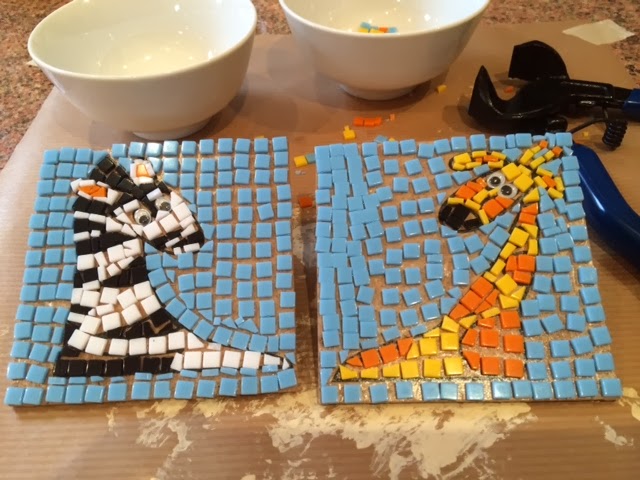I took a trip to Hobby Craft before the Half-Term holidays began to find some craft ideas to keep us busy. I found these very cute kits for making tile mosaic coasters.
The kits contain a square of MDF board with the image outline printed on it, a square of double sided adhesive, tiles, grout and instructions.
The coasters were quite simple to make. I started by sticking the double sided adhesive to the wood, and peeling off the paper to expose the adhesive. The adhesive is transparent, so you could clearly see the outline of the image. The girls used the picture as a guide for placing the tiles and began sticking the tiles to the board.
The example in the photograph shows many cut tiles being used to make a nice image. I tried using a random selection of tools to break the tiles (pliers, grips, hammer, etc), but none of them worked. What you really need is tile nippers. If you want to make your coaster just like the example, you'll need to buy a pair of tile nippers (they aren't included with the kit). Both the girls wanted to be able to cut the tiles and make them fit, so I found this pair of tile nippers on Amazon for £5.98.
I let Olivia have a go at cutting tiles herself (she's a very responsible eight year old) and she did a terrific job. Samantha pointed out the gaps she wanted to fill, and I cut the tiles for her. The tile nippers worked brilliantly. Hardly any pressure was needed to cut a tile. It went much better once we figured out how to hold the tile, so the two cut pieces don't fly across the room! Samantha also had me do the fiddly part of her giraffe, and she filled in the big sections.
Once all the gaps were filled, we had left the adhesive to cure for four hours
Olivia is neat and precise when she does craft, and you can see that she took a lot of time to make her zebra really carefully.
The next step was grouting. We mixed the grout with water (2 parts grout : 1 part water) and using popsicle sticks and a spatula, we spread it on the tiles to fill in all the gaps. The girls then used a damp sponge to carefully wipe the surface, until the grout was only in the gaps and the surface was clean. The coasters overnight to dry properly.
Lastly we painted the back and edges of the MDF board white, so they looked nice and matched the grout. I also added a coat of clear polyurethane varnish over the paint to seal it.
This was a nice, simple craft activity. I liked the fact that the kits were so well prepared. There were plenty of tiles, the adhesive worked well, the design was clearly marked, and all the supplies you needed (except the tile nippers) were there.
read more "Getting Crafty in the School Holidays - Mini Mosaics"
The kits contain a square of MDF board with the image outline printed on it, a square of double sided adhesive, tiles, grout and instructions.
The coasters were quite simple to make. I started by sticking the double sided adhesive to the wood, and peeling off the paper to expose the adhesive. The adhesive is transparent, so you could clearly see the outline of the image. The girls used the picture as a guide for placing the tiles and began sticking the tiles to the board.
The example in the photograph shows many cut tiles being used to make a nice image. I tried using a random selection of tools to break the tiles (pliers, grips, hammer, etc), but none of them worked. What you really need is tile nippers. If you want to make your coaster just like the example, you'll need to buy a pair of tile nippers (they aren't included with the kit). Both the girls wanted to be able to cut the tiles and make them fit, so I found this pair of tile nippers on Amazon for £5.98.
I let Olivia have a go at cutting tiles herself (she's a very responsible eight year old) and she did a terrific job. Samantha pointed out the gaps she wanted to fill, and I cut the tiles for her. The tile nippers worked brilliantly. Hardly any pressure was needed to cut a tile. It went much better once we figured out how to hold the tile, so the two cut pieces don't fly across the room! Samantha also had me do the fiddly part of her giraffe, and she filled in the big sections.
Once all the gaps were filled, we had left the adhesive to cure for four hours
Olivia is neat and precise when she does craft, and you can see that she took a lot of time to make her zebra really carefully.
The next step was grouting. We mixed the grout with water (2 parts grout : 1 part water) and using popsicle sticks and a spatula, we spread it on the tiles to fill in all the gaps. The girls then used a damp sponge to carefully wipe the surface, until the grout was only in the gaps and the surface was clean. The coasters overnight to dry properly.
Lastly we painted the back and edges of the MDF board white, so they looked nice and matched the grout. I also added a coat of clear polyurethane varnish over the paint to seal it.
This was a nice, simple craft activity. I liked the fact that the kits were so well prepared. There were plenty of tiles, the adhesive worked well, the design was clearly marked, and all the supplies you needed (except the tile nippers) were there.




































